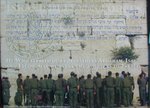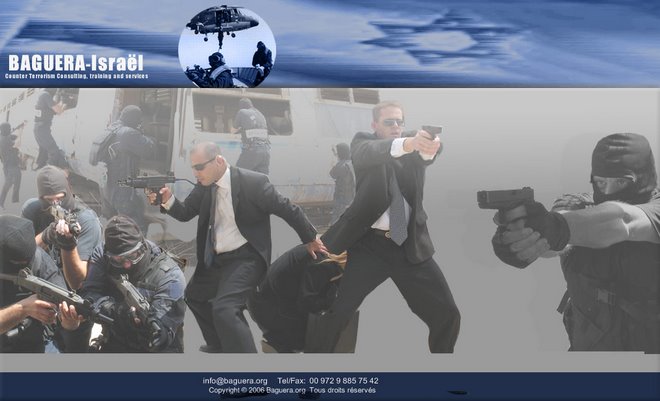Set Your Watch with B'nai Elim Jerusalem Time
Jerusalem On Line - Channel 2 News from Israel
UN Doomsday Treaty With Ginny Simone
16 March 2008
The Jerusalem Viewpoints series is published by the Institute for Contemporary Affairs, founded jointly with the Wechsler Family Foundation at the Jerusalem Center for Public
Affairs.
Jerusalem Viewpoints
No. 562 Adar II - Nisan 5768 / March-April 2008
The U.S. National Intelligence Estimate on Iran
and Its Aftermath:
A Roundtable of Israeli Experts
Maj.-Gen. (res.) Aharon Ze'evi Farkash, former Head of IDF Military Intelligence
Maj.-Gen. (res.) Yaakov Amidror, former Head of Research and Assessment,
IDF Military Intelligence
Brig.-Gen. (res.) Yossi Kuperwasser, former Head of Research and Assessment, IDF Military Intelligence
• The opening sentence of the U.S. National Intelligence Estimate (NIE) of
November 2007 stated: "We judge with high confidence that in Fall 2003,
Tehran halted its nuclear weapons program." This conclusion put the U.S.
intelligence community at odds with Israel, which believes that Iran only
engaged in a temporary halt in 2003, and since that time the Iranian nuclear weapons program had been resumed.
• Israel is not alone in disagreeing with the conclusion of the NIE. Already in
December, just after the NIE's release, Britain's Daily Telegraph reported
London's response with the headline: "Britain: Iran 'Hoodwinked' CIA Over
Nuclear Plans," stating that Britain's intelligence chiefs had "grave doubts
that Iran...mothballed its nuclear weapons program."
• It was in the context of the Western detection of their nuclear program and the Iraq War that led Iran to halt its nuclear program across the board in 2003, with the exception of their surface-to-surface missile program. But prior to that freeze, Iran had been developing a military nuclear capability under a broad civilian cover for fifteen years.
• The Iranian ballistic missile program is part of the Iranian nuclear
weapons program; Iran does not have a civilian space program and it is
doubtful that it would develop ballistic missiles with a range of
thousands of kilometers in order to carry conventional warheads alone.
• Between 2003 and 2005, the Iranians refrained from any nuclear activity
under the influence of the impression created by America's pre-emptive
policies in the region, which served as the main instrument that enabled the Europeans to force Iran to postpone uranium conversion and enrichment. But when the Iranians realized in 2005 that there was no actual threat behind their fears of U.S. pre-emption, they decided to start conversion and then enrichment. As a result, the Iranians already have prepared enough uranium hexafluoride gas (UF6) for more than ten atomic bombs.
Maj.-Gen. (res.) Yaakov Amidror:
The NIE - More Confusion than Clarity
The U.S. National Intelligence Estimate (NIE) of November 2007, entitled Iran: Nuclear Intentions and Capabilities, has created more confusion than clarity. To many observers who heard news reports when it was first released, it appeared that the U.S. intelligence community had concluded that there was no longer any nuclear threat from Iran. That impression was fostered by the opening sentence of the report: "We judge with high confidence that in Fall 2003, Tehran halted its nuclear weapons program." Moving beyond the NIE's first sentence, however, there are other conclusions that seem to suggest the very opposite.
It might be suggested that the seemingly contradictory statements in the NIE are due to the fact that it is a product of sixteen different agencies that belong to the US intelligence community.1 But this would be too simple an explanation. There must have been a consensus of those drafting the report that caused them to lead with the idea that in 2003 Iran was no longer developing nuclear weapons. This conclusion put the U.S. intelligence
community at odds with Israel, whose Defense Minister, Ehud Barak, stated openly that Iran only engaged in a temporary halt in 2003, and since that time the Iranian nuclear weapons program had been resumed.
It was not the first time that the U.S. and Israel disagreed over their assessments about Iran. In 1995, I was the head of the Research and Assessment Division of IDF Military Intelligence and we found the first signs that the Iranians were going nuclear. In those days, we thought the most important action that we could take was to brief our counterparts in Washington and convince them that this was a danger soon to be faced by
the entire Free World. It was not easy to convince them that this subject should be on the table. We sought to do so at a meeting in Washington where a very well-known ambassador represented the U.S. side and I tried to convince the Americans that the Iranians had indeed decided to go nuclear.
At the end of our discussions, the U.S. side gave us the impression that they were thinking to themselves: "After we Americans finish off Iraq as an enemy of the State of Israel, then you Israelis are going to build a new threat because you cannot live without such a threat." During my more than four years as the head of the Assessment Division, this was one of my great failures. It took American experts another two years, until 1997, for the American intelligence community to understand that the Iranians were going nuclear.
Today, Israel is not alone in disagreeing with the conclusion of the NIE. Already in December, just after the NIE's release, Britain's Daily Telegraph reported London's response with the headline: "Britain: Iran 'Hoodwinked' CIA Over Nuclear Plans," stating that Britain's intelligence chiefs had "grave doubts that Iran...mothballed its nuclear weapons program."2 French President Nicolas Sarkozy and German Chancellor Angela Merkel also went out of their way to state that Iran still remained a danger and pressure
had to be kept up over its nuclear program.3 Even officials at the International Atomic Energy Agency (IAEA), who were traditionally more forgiving about Iranian behavior than the U.S., expressed doubts about the NIE right after it was released. One official stated: "We don't buy the American analysis 100 percent. We are not that generous with Iran."4
While we are dealing only with the public version of the NIE, we understand that there is no fundamental difference between this version and the unpublished version. For this reason, it is very important that the NIE be carefully analyzed. There is no argument about the civilian side: Iranian enrichment efforts continue. But what we need to focus upon are Iran's purely military capabilities. We believe that this report of the U.S. intelligence community was a huge mistake from both a methodological and professional point of view. I would not have permitted such a report to be issued by Israeli Military Intelligence while containing such holes in its arguments.
It is noteworthy how Admiral Mike McConnell, the U.S. Director of National
Intelligence, tried to correct the impression created by the NIE in his remarks to the Senate Intelligence Committee in February 2008: "The only thing they've halted was nuclear weapons design, which is probably the least significant part of the program."5 For a detailed look at the NIE, Maj.-Gen. (res.) Aharon Ze'evi Farkash, who served as head of Israeli Military Intelligence from 2001 to 2006, offers his own insights into the evolution
of the Iranian nuclear program.
Maj.-Gen. (res.) Aharon Ze'evi Farkash:
No Evidence that Iran Did Not Renew Nuclear Weaponization Work
In August 2002, Iran understood that the Western countries - U.S., the EU-3 (France, Germany, and the United Kingdom), and Israel - had obtained hard information that Iran was conducting a clandestine nuclear weapons program. Shortly thereafter, in March 2003, the regional environment quickly became dominated by the outbreak of the Iraq War and the downfall of Saddam Hussein. By July 2003, the Iranians opened negotiations with the EU-3, which sought to halt the Iranian nuclear program. At the end of the same year, Qaddafi stopped Libya's nuclear military plans.
It was in the context of the Western detection of their nuclear program and the Iraq War that led Iran to halt its nuclear program across the board in 2003, with the exception of their surface-to-surface missile program. But prior to that freeze, Iran was developing a military nuclear capability under a broad civilian cover. The participants were the Atomic Energy Organization of Iran (AEOI) and the Iranian Ministry of Defense (MOD).
A nuclear weapons program is comprised of three key elements:
1) A delivery system, requiring the development of surface-to-surface missiles.
2) The accumulation of fissile material through uranium enrichment and plutonium production.
3) Weaponization - preparing a warhead from the fissile material and fitting it into a missile.
Several of these elements in the Iranian nuclear program were in fact soon resumed. At the beginning of 2003, the Iranians were concentrating all their efforts on the centrifuge program at their facility in Natanz, where they had managed to build a cascade with 164 centrifuges. Today, they have reached a capacity of 3,000 centrifuges. If parts of the nuclear weapons program were restarted, there is every reason to believe that all parts were reactivated as well. Indeed, Iran's development of surface-to-surface missiles had never ceased, even when uranium enrichment had been temporarily halted.
At the same time, the Iranians were busy with procurement activities, with a focus on obtaining all the materials and components needed for uranium enrichment. At the beginning of 2004, we know that Iran was attempting to procure fast high voltage switches suitable for a nuclear weapons system. The Iranian Ministry of Defense was also supervising the mining of uranium in southeast Iran.
According to information provided by the Iranian opposition, Lavizan was one of the sites that dealt with Iran's weaponization program, and the IAEA requested to visit Lavizan in September-October 2003. By March 2004, the Lavizan facility had disappeared; it had been dismantled. When Iran renewed its nuclear enrichment program in January 2005, there is no evidence that they did not renew the work of the weaponization group at the same time.
Editor's note: In February 2008, the Iranian opposition charged that Iran had erected a new command and control center: code-named Lavizan-2. In addition, they identified yet another facility at Khojir, where they claimed the production of nuclear warheads was being undertaken.6
Developing the Missiles to Deliver a Nuclear Payload
Together with developing a nuclear weapon, Iran has been developing an
appropriate long-range delivery system. Its Shihab 3 missile can carry a warhead of approximately 700 kilograms over a distance of 1,300-1,500 kilometers. These missiles are under the command of the Revolutionary Guard, not the Iranian military. The Revolutionary Guard reports to Supreme Leader Ali Khamenei and it is not under the authority of President Ahmadinejad. Iranian missile exercises showed that the missiles are aimed at both Tel Aviv and Riyadh.
Iran is continuing to develop even longer-range missiles with a range of 3,500-5,000 kilometers that could reach all of Europe (perhaps with the exception of Portugal), while those with a range of 6,000-10,000 kilometers could reach the east coast of the U.S. The original missile technology was delivered to the Iranians by North Korea, and the Iranians have made substantial efforts to improve their range. As we know, the Iranian ballistic missile program is part of the Iranian nuclear weapons program; Iran does not have a civilian space program and it is doubtful that it would develop ballistic missiles with a range of thousands of kilometers in order to carry
conventional warheads alone.
European Reaction to the Iranian Missile Threat
As Director of IDF Military Intelligence, I briefed leaders in Europe about Iran's nuclear military plans and met personally with decision-makers in Italy, France, the UK, and other European countries over a period of six months. Most of the European leaders understood the data about Iran's nuclear plans, but their response was not encouraging.
The Europeans said they did not understand why Israel was trying to scare them with a nuclear military threat since they had lived with such a threat during the Cold War. They were also of the opinion that, in the end, if Iran did achieve a nuclear military capability, the U.S. and Israel would solve the problem, and I believe this remains their attitude today.
What Does the NIE Say?
The U.S. National Intelligence Estimate summary report says that in 2003, Tehran halted its nuclear weapons program, but the NIE's headline finding is written in such a way that guarantees that its other conclusions will be misunderstood.
• In Paragraph C, the NIE summary states that Iran made significant
progress in 2007 installing centrifuges at Natanz. Based upon this
finding, Israeli military intelligence estimates that late 2009 is the
earliest possible date that Iran will be technically capable of
producing enough highly enriched uranium for a weapon.
• Paragraph D of the NIE says that Iranian entities are continuing to
develop a range of technical capabilities that could be applied to
producing nuclear weapons if a decision is made to do so. Thus, Iran's
continuing civilian uranium enrichment program could produce
enough fissile materials by the end of 2009 or 2010.
• Paragraph F of the NIE notes: We assess that Iran probably would use
covert facilities rather than its declared nuclear sites for the
production of highly enriched uranium for a weapon.
• Finally, Paragraph H of the NIE states: We assess that Iran has the
scientific, technical, and industrial capacity to produce nuclear
weapons if it decides to do so.
All of this means that the Iranians will have enough fissile material no later than 2010 and that if they decide to build a nuclear military plant, no one can promise that we or the Americans will know about it, if they indeed actually did halt their nuclear weapons program in 2003. It would be a mistake to conclude that Iranian nuclear weapons ambitions have been halted on the basis of reading the first sentence of the NIE alone.
In my view, any distinction between Iranian military and civilian nuclear programs is artificial. The enrichment of uranium, critical to both civilian and military uses, is continuing. Once they have enough enriched uranium, they will be 3-6 months away from building a nuclear bomb if they decide to do so.
Pressure on Iran Dissipates after the NIE
After the NIE report was released, the declaration that Tehran had halted its nuclear weapons program was reported by all of the world's major media without any contradicting information. Soon thereafter, Russia and Iran reached agreement on a schedule to complete the plutonium-based nuclear facility in Bushehr. This was followed by an announcement that China and Iran had signed a $2.3 billion economic agreement related to energy that had been on hold for more than half a year. Prior to this, China had come to join the economic pressure on Iran. In addition, Ahmadinejad formally visited Riyadh, and a new Egyptian-Iranian relationship began to develop for the first time since Sadat's assassination.
The NIE has clearly weakened international support for tougher sanctions against Iran, and it closes off any military option for the Bush administration. The NIE has sent a signal to Tehran that the danger of external sanctions has ended. Furthermore, the NIE has weakened Turkey and the moderate Sunni countries in the region that were seeking to build a coalition against Iran. So, ironically, the NIE opens the way for Iran to achieve its military nuclear ambitions without any interference.
Brig.-Gen. (res.) Yossi Kuperwasser:
The NIE: A Very Poor Intelligence Product
The main problem with the NIE is the phrasing of its message. It's a very poor intelligence product because it is not only a matter of what you say but also how you say it and what you don't say.
One of the major issues that arise from the report is its admission that the Iranians had a nuclear weaponization project for fifteen years, from the end of the 1980s until 2003.How far did the Iranians go in those fifteen years? How many obstacles do they still face?
By saying that if the Iranians have the ability to enrich uranium, they can have a bomb within a very short period of time, the NIE actually alludes to the idea that the Iranians have already gone a very long way in the context of weaponization. So why doesn't the NIE say so explicitly? The first thing an intelligence organization has to know is to ask the right questions, but this question is not asked, nor is it answered.
Furthermore, it is a totally wrong approach to make this differentiation between the military and the civilian parts of the Iranian nuclear program. It's all one program. Part of it can be justified by civilian needs, so the Iranians do it under civilian cover. Part of it cannot be justified by civilian needs, but it is all part of the same program, and the part of the program that is designated to develop the fissile material is ongoing.
Between 2003 and 2005, the Iranians refrained from any nuclear activity. They were under the influence of the impression created by America's pre-emptive policies in the region in Iraq and Afghanistan, which served as the main instrument that enabled the Europeans to force Iran to make a deal and to postpone uranium conversion and enrichment. But when the Iranians realized in 2005 that there was no actual threat behind their fears of U.S. pre-emption, they decided to take the risk and start conversion and then
enrichment.
In other words, once the U.S. appeared to be entangled in Iraq, a situation to which the Iranians themselves made no small contribution, Tehran could return to vigorously advancing its nuclear program. The fact is that Iran has moved forward with conversion. As a result, the Iranians already have prepared, through the conversion process, enough uranium hexaflouride gas (UF6) for more than ten atomic bombs.
Iran has moved forward with enrichment too. There is a debate in the NIE report over where exactly the Iranians are in their enrichment R&D. Some claim that maybe they have not yet reached the point where they can really perform enrichment in a robust way and not worry about failing. But there's no doubt that they have spent at least two years on R&D.
If we believe the NIE judgment about their technical capabilities, then the Iranians are not far away from the point where they will have the ability to produce an ample supply of enriched uranium in order to make a bomb. Bearing in mind that they probably have everything else they need to proceed, the Iranians will be able to do whatever is still needed to finish their weaponization activities without being worried about a military
move. Only such a military move can really stop them right now. So we see the harsh repercussions of the very poor work that the American intelligence agencies have done.
* * *
Notes
1. Mark Mazzetti, "U.S. Says Iran Ended Atomic Arms Work," New York Times, December 3, 2007, http://www.nytimes.com/2007/12/03/world/middleeast/03cnd-iran.html
2. Tim Shipman, Philip Sherwell and Carolynne Wheeler, "Britain; Iran 'Hoodwinked' CIA Over Nuclear Plans," Daily Telegraph, December 10, 2007,
http://www.telegraph.co.uk/news/main.jhtml?xml=/news/2007/12/09/wiran109.xml
3. Katrin Bennhold, "Despite Report, France and Germany Keep Pressure on Iran," New York Times, December 7, 2007, http://www.nytimes.com/2007/12/07/world/middleeast/07iran.html
4. Elaine Sciolino, "Monitoring Agency Praises U.S. Report, But Keeps Wary Eye on Iran," New York Times, December 5, 2007, http://www.nytimes.com/2007/12/05/world/middleeast/05iran.html
5. Demetri Sevastopulo, "Intelligence Official Revives Iran Doubts," Financial Times, February 6, 2008, http://www.ft.com/cms/s/0/a1ce672e-d456-11dc-a8c6-0000779fd2ac.html
6. David Brunnstrom, "Iranian Dissidents Urge Immediate Nuclear Checks," Reuters, February 20, 2008, http://www.reuters.com/article/latestCrisis/idUSL20165281
* * *
Maj.-Gen. (res.) Aharon Ze'evi Farkash served as Director of IDF Military
Intelligence from 2001 to 2006. He previously served as Head of the Technology and Logistics Division, and as Deputy Head of the IDF Planning Division.
Maj.-Gen. (res.) Yaakov Amidror, Program Director of the Institute for Contemporary Affairs at the Jerusalem Center for Public Affairs and Vice President of the Lander Institute in Jerusalem, is former commander of the IDF's National Defense College and the IDF Staff and Command College. He is also the former head of the Research and Assessment Division of Military Intelligence, with special responsibility for preparing the National Intelligence Assessment. In addition, he served as the military secretary of the Minister of Defense.
Brig.-Gen. (res.) Yossi Kuperwasser served in a number of senior roles in the IDF, most recently as head of the Research and Assessment Division of Military Intelligence. Previously, he was the senior intelligence officer of the IDF Central Command.
The Jerusalem Letter and Jerusalem Viewpoints are published by the Jerusalem Center for
Public Affairs, 13 Tel-Hai St., Jerusalem, Israel; Tel. 972-2-5619281, Fax. 972-2-5619112,
Internet: jcpa@netvision.net.il. In U.S.A.: Center for Jewish Community Studies, 5800 Park
Heights Avenue, Baltimore, MD 21215 USA, Tel. (410) 664-5222; Fax. (410) 664-1228. ©
Copyright. All rights reserved. ISSN: 0792-7304.
The opinions expressed by the authors of Jerusalem Viewpoints do not necessarily reflect those of the Jerusalem Center for Public Affairs.
Affairs.
Jerusalem Viewpoints
No. 562 Adar II - Nisan 5768 / March-April 2008
The U.S. National Intelligence Estimate on Iran
and Its Aftermath:
A Roundtable of Israeli Experts
Maj.-Gen. (res.) Aharon Ze'evi Farkash, former Head of IDF Military Intelligence
Maj.-Gen. (res.) Yaakov Amidror, former Head of Research and Assessment,
IDF Military Intelligence
Brig.-Gen. (res.) Yossi Kuperwasser, former Head of Research and Assessment, IDF Military Intelligence
• The opening sentence of the U.S. National Intelligence Estimate (NIE) of
November 2007 stated: "We judge with high confidence that in Fall 2003,
Tehran halted its nuclear weapons program." This conclusion put the U.S.
intelligence community at odds with Israel, which believes that Iran only
engaged in a temporary halt in 2003, and since that time the Iranian nuclear weapons program had been resumed.
• Israel is not alone in disagreeing with the conclusion of the NIE. Already in
December, just after the NIE's release, Britain's Daily Telegraph reported
London's response with the headline: "Britain: Iran 'Hoodwinked' CIA Over
Nuclear Plans," stating that Britain's intelligence chiefs had "grave doubts
that Iran...mothballed its nuclear weapons program."
• It was in the context of the Western detection of their nuclear program and the Iraq War that led Iran to halt its nuclear program across the board in 2003, with the exception of their surface-to-surface missile program. But prior to that freeze, Iran had been developing a military nuclear capability under a broad civilian cover for fifteen years.
• The Iranian ballistic missile program is part of the Iranian nuclear
weapons program; Iran does not have a civilian space program and it is
doubtful that it would develop ballistic missiles with a range of
thousands of kilometers in order to carry conventional warheads alone.
• Between 2003 and 2005, the Iranians refrained from any nuclear activity
under the influence of the impression created by America's pre-emptive
policies in the region, which served as the main instrument that enabled the Europeans to force Iran to postpone uranium conversion and enrichment. But when the Iranians realized in 2005 that there was no actual threat behind their fears of U.S. pre-emption, they decided to start conversion and then enrichment. As a result, the Iranians already have prepared enough uranium hexafluoride gas (UF6) for more than ten atomic bombs.
Maj.-Gen. (res.) Yaakov Amidror:
The NIE - More Confusion than Clarity
The U.S. National Intelligence Estimate (NIE) of November 2007, entitled Iran: Nuclear Intentions and Capabilities, has created more confusion than clarity. To many observers who heard news reports when it was first released, it appeared that the U.S. intelligence community had concluded that there was no longer any nuclear threat from Iran. That impression was fostered by the opening sentence of the report: "We judge with high confidence that in Fall 2003, Tehran halted its nuclear weapons program." Moving beyond the NIE's first sentence, however, there are other conclusions that seem to suggest the very opposite.
It might be suggested that the seemingly contradictory statements in the NIE are due to the fact that it is a product of sixteen different agencies that belong to the US intelligence community.1 But this would be too simple an explanation. There must have been a consensus of those drafting the report that caused them to lead with the idea that in 2003 Iran was no longer developing nuclear weapons. This conclusion put the U.S. intelligence
community at odds with Israel, whose Defense Minister, Ehud Barak, stated openly that Iran only engaged in a temporary halt in 2003, and since that time the Iranian nuclear weapons program had been resumed.
It was not the first time that the U.S. and Israel disagreed over their assessments about Iran. In 1995, I was the head of the Research and Assessment Division of IDF Military Intelligence and we found the first signs that the Iranians were going nuclear. In those days, we thought the most important action that we could take was to brief our counterparts in Washington and convince them that this was a danger soon to be faced by
the entire Free World. It was not easy to convince them that this subject should be on the table. We sought to do so at a meeting in Washington where a very well-known ambassador represented the U.S. side and I tried to convince the Americans that the Iranians had indeed decided to go nuclear.
At the end of our discussions, the U.S. side gave us the impression that they were thinking to themselves: "After we Americans finish off Iraq as an enemy of the State of Israel, then you Israelis are going to build a new threat because you cannot live without such a threat." During my more than four years as the head of the Assessment Division, this was one of my great failures. It took American experts another two years, until 1997, for the American intelligence community to understand that the Iranians were going nuclear.
Today, Israel is not alone in disagreeing with the conclusion of the NIE. Already in December, just after the NIE's release, Britain's Daily Telegraph reported London's response with the headline: "Britain: Iran 'Hoodwinked' CIA Over Nuclear Plans," stating that Britain's intelligence chiefs had "grave doubts that Iran...mothballed its nuclear weapons program."2 French President Nicolas Sarkozy and German Chancellor Angela Merkel also went out of their way to state that Iran still remained a danger and pressure
had to be kept up over its nuclear program.3 Even officials at the International Atomic Energy Agency (IAEA), who were traditionally more forgiving about Iranian behavior than the U.S., expressed doubts about the NIE right after it was released. One official stated: "We don't buy the American analysis 100 percent. We are not that generous with Iran."4
While we are dealing only with the public version of the NIE, we understand that there is no fundamental difference between this version and the unpublished version. For this reason, it is very important that the NIE be carefully analyzed. There is no argument about the civilian side: Iranian enrichment efforts continue. But what we need to focus upon are Iran's purely military capabilities. We believe that this report of the U.S. intelligence community was a huge mistake from both a methodological and professional point of view. I would not have permitted such a report to be issued by Israeli Military Intelligence while containing such holes in its arguments.
It is noteworthy how Admiral Mike McConnell, the U.S. Director of National
Intelligence, tried to correct the impression created by the NIE in his remarks to the Senate Intelligence Committee in February 2008: "The only thing they've halted was nuclear weapons design, which is probably the least significant part of the program."5 For a detailed look at the NIE, Maj.-Gen. (res.) Aharon Ze'evi Farkash, who served as head of Israeli Military Intelligence from 2001 to 2006, offers his own insights into the evolution
of the Iranian nuclear program.
Maj.-Gen. (res.) Aharon Ze'evi Farkash:
No Evidence that Iran Did Not Renew Nuclear Weaponization Work
In August 2002, Iran understood that the Western countries - U.S., the EU-3 (France, Germany, and the United Kingdom), and Israel - had obtained hard information that Iran was conducting a clandestine nuclear weapons program. Shortly thereafter, in March 2003, the regional environment quickly became dominated by the outbreak of the Iraq War and the downfall of Saddam Hussein. By July 2003, the Iranians opened negotiations with the EU-3, which sought to halt the Iranian nuclear program. At the end of the same year, Qaddafi stopped Libya's nuclear military plans.
It was in the context of the Western detection of their nuclear program and the Iraq War that led Iran to halt its nuclear program across the board in 2003, with the exception of their surface-to-surface missile program. But prior to that freeze, Iran was developing a military nuclear capability under a broad civilian cover. The participants were the Atomic Energy Organization of Iran (AEOI) and the Iranian Ministry of Defense (MOD).
A nuclear weapons program is comprised of three key elements:
1) A delivery system, requiring the development of surface-to-surface missiles.
2) The accumulation of fissile material through uranium enrichment and plutonium production.
3) Weaponization - preparing a warhead from the fissile material and fitting it into a missile.
Several of these elements in the Iranian nuclear program were in fact soon resumed. At the beginning of 2003, the Iranians were concentrating all their efforts on the centrifuge program at their facility in Natanz, where they had managed to build a cascade with 164 centrifuges. Today, they have reached a capacity of 3,000 centrifuges. If parts of the nuclear weapons program were restarted, there is every reason to believe that all parts were reactivated as well. Indeed, Iran's development of surface-to-surface missiles had never ceased, even when uranium enrichment had been temporarily halted.
At the same time, the Iranians were busy with procurement activities, with a focus on obtaining all the materials and components needed for uranium enrichment. At the beginning of 2004, we know that Iran was attempting to procure fast high voltage switches suitable for a nuclear weapons system. The Iranian Ministry of Defense was also supervising the mining of uranium in southeast Iran.
According to information provided by the Iranian opposition, Lavizan was one of the sites that dealt with Iran's weaponization program, and the IAEA requested to visit Lavizan in September-October 2003. By March 2004, the Lavizan facility had disappeared; it had been dismantled. When Iran renewed its nuclear enrichment program in January 2005, there is no evidence that they did not renew the work of the weaponization group at the same time.
Editor's note: In February 2008, the Iranian opposition charged that Iran had erected a new command and control center: code-named Lavizan-2. In addition, they identified yet another facility at Khojir, where they claimed the production of nuclear warheads was being undertaken.6
Developing the Missiles to Deliver a Nuclear Payload
Together with developing a nuclear weapon, Iran has been developing an
appropriate long-range delivery system. Its Shihab 3 missile can carry a warhead of approximately 700 kilograms over a distance of 1,300-1,500 kilometers. These missiles are under the command of the Revolutionary Guard, not the Iranian military. The Revolutionary Guard reports to Supreme Leader Ali Khamenei and it is not under the authority of President Ahmadinejad. Iranian missile exercises showed that the missiles are aimed at both Tel Aviv and Riyadh.
Iran is continuing to develop even longer-range missiles with a range of 3,500-5,000 kilometers that could reach all of Europe (perhaps with the exception of Portugal), while those with a range of 6,000-10,000 kilometers could reach the east coast of the U.S. The original missile technology was delivered to the Iranians by North Korea, and the Iranians have made substantial efforts to improve their range. As we know, the Iranian ballistic missile program is part of the Iranian nuclear weapons program; Iran does not have a civilian space program and it is doubtful that it would develop ballistic missiles with a range of thousands of kilometers in order to carry
conventional warheads alone.
European Reaction to the Iranian Missile Threat
As Director of IDF Military Intelligence, I briefed leaders in Europe about Iran's nuclear military plans and met personally with decision-makers in Italy, France, the UK, and other European countries over a period of six months. Most of the European leaders understood the data about Iran's nuclear plans, but their response was not encouraging.
The Europeans said they did not understand why Israel was trying to scare them with a nuclear military threat since they had lived with such a threat during the Cold War. They were also of the opinion that, in the end, if Iran did achieve a nuclear military capability, the U.S. and Israel would solve the problem, and I believe this remains their attitude today.
What Does the NIE Say?
The U.S. National Intelligence Estimate summary report says that in 2003, Tehran halted its nuclear weapons program, but the NIE's headline finding is written in such a way that guarantees that its other conclusions will be misunderstood.
• In Paragraph C, the NIE summary states that Iran made significant
progress in 2007 installing centrifuges at Natanz. Based upon this
finding, Israeli military intelligence estimates that late 2009 is the
earliest possible date that Iran will be technically capable of
producing enough highly enriched uranium for a weapon.
• Paragraph D of the NIE says that Iranian entities are continuing to
develop a range of technical capabilities that could be applied to
producing nuclear weapons if a decision is made to do so. Thus, Iran's
continuing civilian uranium enrichment program could produce
enough fissile materials by the end of 2009 or 2010.
• Paragraph F of the NIE notes: We assess that Iran probably would use
covert facilities rather than its declared nuclear sites for the
production of highly enriched uranium for a weapon.
• Finally, Paragraph H of the NIE states: We assess that Iran has the
scientific, technical, and industrial capacity to produce nuclear
weapons if it decides to do so.
All of this means that the Iranians will have enough fissile material no later than 2010 and that if they decide to build a nuclear military plant, no one can promise that we or the Americans will know about it, if they indeed actually did halt their nuclear weapons program in 2003. It would be a mistake to conclude that Iranian nuclear weapons ambitions have been halted on the basis of reading the first sentence of the NIE alone.
In my view, any distinction between Iranian military and civilian nuclear programs is artificial. The enrichment of uranium, critical to both civilian and military uses, is continuing. Once they have enough enriched uranium, they will be 3-6 months away from building a nuclear bomb if they decide to do so.
Pressure on Iran Dissipates after the NIE
After the NIE report was released, the declaration that Tehran had halted its nuclear weapons program was reported by all of the world's major media without any contradicting information. Soon thereafter, Russia and Iran reached agreement on a schedule to complete the plutonium-based nuclear facility in Bushehr. This was followed by an announcement that China and Iran had signed a $2.3 billion economic agreement related to energy that had been on hold for more than half a year. Prior to this, China had come to join the economic pressure on Iran. In addition, Ahmadinejad formally visited Riyadh, and a new Egyptian-Iranian relationship began to develop for the first time since Sadat's assassination.
The NIE has clearly weakened international support for tougher sanctions against Iran, and it closes off any military option for the Bush administration. The NIE has sent a signal to Tehran that the danger of external sanctions has ended. Furthermore, the NIE has weakened Turkey and the moderate Sunni countries in the region that were seeking to build a coalition against Iran. So, ironically, the NIE opens the way for Iran to achieve its military nuclear ambitions without any interference.
Brig.-Gen. (res.) Yossi Kuperwasser:
The NIE: A Very Poor Intelligence Product
The main problem with the NIE is the phrasing of its message. It's a very poor intelligence product because it is not only a matter of what you say but also how you say it and what you don't say.
One of the major issues that arise from the report is its admission that the Iranians had a nuclear weaponization project for fifteen years, from the end of the 1980s until 2003.How far did the Iranians go in those fifteen years? How many obstacles do they still face?
By saying that if the Iranians have the ability to enrich uranium, they can have a bomb within a very short period of time, the NIE actually alludes to the idea that the Iranians have already gone a very long way in the context of weaponization. So why doesn't the NIE say so explicitly? The first thing an intelligence organization has to know is to ask the right questions, but this question is not asked, nor is it answered.
Furthermore, it is a totally wrong approach to make this differentiation between the military and the civilian parts of the Iranian nuclear program. It's all one program. Part of it can be justified by civilian needs, so the Iranians do it under civilian cover. Part of it cannot be justified by civilian needs, but it is all part of the same program, and the part of the program that is designated to develop the fissile material is ongoing.
Between 2003 and 2005, the Iranians refrained from any nuclear activity. They were under the influence of the impression created by America's pre-emptive policies in the region in Iraq and Afghanistan, which served as the main instrument that enabled the Europeans to force Iran to make a deal and to postpone uranium conversion and enrichment. But when the Iranians realized in 2005 that there was no actual threat behind their fears of U.S. pre-emption, they decided to take the risk and start conversion and then
enrichment.
In other words, once the U.S. appeared to be entangled in Iraq, a situation to which the Iranians themselves made no small contribution, Tehran could return to vigorously advancing its nuclear program. The fact is that Iran has moved forward with conversion. As a result, the Iranians already have prepared, through the conversion process, enough uranium hexaflouride gas (UF6) for more than ten atomic bombs.
Iran has moved forward with enrichment too. There is a debate in the NIE report over where exactly the Iranians are in their enrichment R&D. Some claim that maybe they have not yet reached the point where they can really perform enrichment in a robust way and not worry about failing. But there's no doubt that they have spent at least two years on R&D.
If we believe the NIE judgment about their technical capabilities, then the Iranians are not far away from the point where they will have the ability to produce an ample supply of enriched uranium in order to make a bomb. Bearing in mind that they probably have everything else they need to proceed, the Iranians will be able to do whatever is still needed to finish their weaponization activities without being worried about a military
move. Only such a military move can really stop them right now. So we see the harsh repercussions of the very poor work that the American intelligence agencies have done.
* * *
Notes
1. Mark Mazzetti, "U.S. Says Iran Ended Atomic Arms Work," New York Times, December 3, 2007, http://www.nytimes.com/2007/12/03/world/middleeast/03cnd-iran.html
2. Tim Shipman, Philip Sherwell and Carolynne Wheeler, "Britain; Iran 'Hoodwinked' CIA Over Nuclear Plans," Daily Telegraph, December 10, 2007,
http://www.telegraph.co.uk/news/main.jhtml?xml=/news/2007/12/09/wiran109.xml
3. Katrin Bennhold, "Despite Report, France and Germany Keep Pressure on Iran," New York Times, December 7, 2007, http://www.nytimes.com/2007/12/07/world/middleeast/07iran.html
4. Elaine Sciolino, "Monitoring Agency Praises U.S. Report, But Keeps Wary Eye on Iran," New York Times, December 5, 2007, http://www.nytimes.com/2007/12/05/world/middleeast/05iran.html
5. Demetri Sevastopulo, "Intelligence Official Revives Iran Doubts," Financial Times, February 6, 2008, http://www.ft.com/cms/s/0/a1ce672e-d456-11dc-a8c6-0000779fd2ac.html
6. David Brunnstrom, "Iranian Dissidents Urge Immediate Nuclear Checks," Reuters, February 20, 2008, http://www.reuters.com/article/latestCrisis/idUSL20165281
* * *
Maj.-Gen. (res.) Aharon Ze'evi Farkash served as Director of IDF Military
Intelligence from 2001 to 2006. He previously served as Head of the Technology and Logistics Division, and as Deputy Head of the IDF Planning Division.
Maj.-Gen. (res.) Yaakov Amidror, Program Director of the Institute for Contemporary Affairs at the Jerusalem Center for Public Affairs and Vice President of the Lander Institute in Jerusalem, is former commander of the IDF's National Defense College and the IDF Staff and Command College. He is also the former head of the Research and Assessment Division of Military Intelligence, with special responsibility for preparing the National Intelligence Assessment. In addition, he served as the military secretary of the Minister of Defense.
Brig.-Gen. (res.) Yossi Kuperwasser served in a number of senior roles in the IDF, most recently as head of the Research and Assessment Division of Military Intelligence. Previously, he was the senior intelligence officer of the IDF Central Command.
The Jerusalem Letter and Jerusalem Viewpoints are published by the Jerusalem Center for
Public Affairs, 13 Tel-Hai St., Jerusalem, Israel; Tel. 972-2-5619281, Fax. 972-2-5619112,
Internet: jcpa@netvision.net.il. In U.S.A.: Center for Jewish Community Studies, 5800 Park
Heights Avenue, Baltimore, MD 21215 USA, Tel. (410) 664-5222; Fax. (410) 664-1228. ©
Copyright. All rights reserved. ISSN: 0792-7304.
The opinions expressed by the authors of Jerusalem Viewpoints do not necessarily reflect those of the Jerusalem Center for Public Affairs.
Subscribe to:
Post Comments (Atom)
Colonel Richard Kemp, British Army - Comment on the IDF's Actions in Gaza
Radical Islams Plans for Western Civilization
THE THIRD JIHAD - WATCH THIS IMPORTANT FILM NOW - FREE
Obama's true agenda...Throw Israel Under the Bus
****Regarding Obama’s Speech before the U.N. Obama has surpassed the peanut farmer Jimmy Carter as the worst and most anti-Israel, anti-Semitic, Arabist President who has ever occupied the White House. Not only is he is a narcissistic moron who is dragging America into an abyss; Obama is the most dangerous threat to World Freedom, Liberty and Western Civilization since Hitler. (Blogmaster)
Senator Joe Leiberman 'Islamist Extremist Regime'
JOHN VOIGHT ON OBAMA'S DISTAIN FOR ISRAEL
CHAZAK CHAZAK
ON THE PATH TO MUSLIM DOMINATION - REVERSABLE? STOPPABLE?
2 STATE SOLUTION - COMMENTARY BY THE "18"
A message to the Jewish people and the entire world
Chronicles I - 16:15-18: "Forever remember His covenant that he commanded forever; That He made with Abraham and swore to Isaac; and confirmed in a decree for Jacob, for Israel, as an eternal covenant; saying to You I will give the Land of Cannan as your alloted heritage"
































 While doing IDF (Israel Defence Forces) reserve duty on a mountain overlooking the
While doing IDF (Israel Defence Forces) reserve duty on a mountain overlooking the 





Hi!
ReplyDeleteThis is Nice Blog!
We offers conversion from various file formats and media to other. With our extensive technical expertise in this area, we are almost certain to cater to any of your complex xml/sgml
conversion requirements, be it in any format, file types or media.